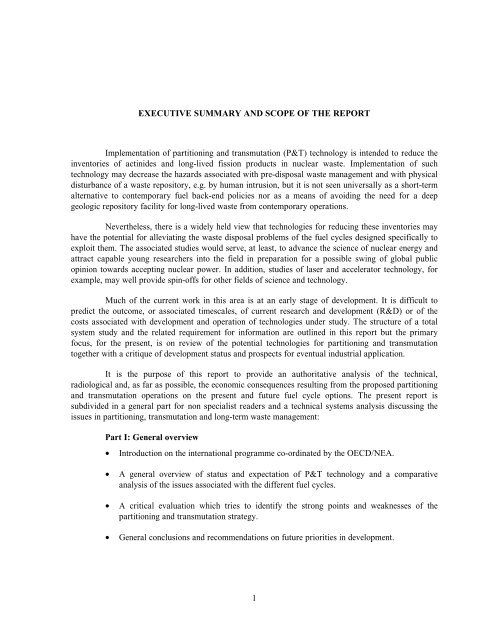COMPLETE DOCUMENT (1862 kb) - OECD Nuclear Energy Agency
COMPLETE DOCUMENT (1862 kb) - OECD Nuclear Energy Agency
COMPLETE DOCUMENT (1862 kb) - OECD Nuclear Energy Agency
You also want an ePaper? Increase the reach of your titles
YUMPU automatically turns print PDFs into web optimized ePapers that Google loves.
EXECUTIVE SUMMARY AND SCOPE OF THE REPORT<br />
Implementation of partitioning and transmutation (P&T) technology is intended to reduce the<br />
inventories of actinides and long-lived fission products in nuclear waste. Implementation of such<br />
technology may decrease the hazards associated with pre-disposal waste management and with physical<br />
disturbance of a waste repository, e.g. by human intrusion, but it is not seen universally as a short-term<br />
alternative to contemporary fuel back-end policies nor as a means of avoiding the need for a deep<br />
geologic repository facility for long-lived waste from contemporary operations.<br />
Nevertheless, there is a widely held view that technologies for reducing these inventories may<br />
have the potential for alleviating the waste disposal problems of the fuel cycles designed specifically to<br />
exploit them. The associated studies would serve, at least, to advance the science of nuclear energy and<br />
attract capable young researchers into the field in preparation for a possible swing of global public<br />
opinion towards accepting nuclear power. In addition, studies of laser and accelerator technology, for<br />
example, may well provide spin-offs for other fields of science and technology.<br />
Much of the current work in this area is at an early stage of development. It is difficult to<br />
predict the outcome, or associated timescales, of current research and development (R&D) or of the<br />
costs associated with development and operation of technologies under study. The structure of a total<br />
system study and the related requirement for information are outlined in this report but the primary<br />
focus, for the present, is on review of the potential technologies for partitioning and transmutation<br />
together with a critique of development status and prospects for eventual industrial application.<br />
It is the purpose of this report to provide an authoritative analysis of the technical,<br />
radiological and, as far as possible, the economic consequences resulting from the proposed partitioning<br />
and transmutation operations on the present and future fuel cycle options. The present report is<br />
subdivided in a general part for non specialist readers and a technical systems analysis discussing the<br />
issues in partitioning, transmutation and long-term waste management:<br />
Part I: General overview<br />
• Introduction on the international programme co-ordinated by the <strong>OECD</strong>/NEA.<br />
• A general overview of status and expectation of P&T technology and a comparative<br />
analysis of the issues associated with the different fuel cycles.<br />
• A critical evaluation which tries to identify the strong points and weaknesses of the<br />
partitioning and transmutation strategy.<br />
• General conclusions and recommendations on future priorities in development.<br />
1
















